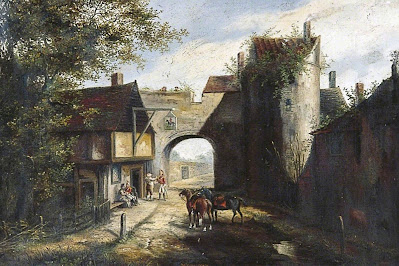The beauty of many cities in England is
measured by the value of their cathedral, and it is not surprising thinking of examples
such as Salisbury, Winchester, or York; three cities with spectacular
cathedrals. Hosting the headquarters of the Church of England, and having the
oldest cathedral in the country, Canterbury offered me a similar experience.
Just 100 kilometres south-east of central London, the Kentish capital is one of
the most popular places for a day trip from London, offering history, culture,
and plenty of life at every corner. A town that thousands of pilgrims have visited
over the centuries. Canterbury has always been a transit point, thanks to being
halfway between Dover, the closest point to France, and London. It was a Roman settlement,
and it was the capital of the Saxon kingdom of Kent when in the year 597 Saint
Augustine arrived, sent by the Pope to establish the Christian faith in the
British Isles. Saint Augustine chose Canterbury as his professorship and his
Christ Church monastery would eventually become England's first cathedral.
The legend of Canterbury began when a power struggle between King Henry II and Archbishop Thomas Becket ended with the latter's assassination in 1170. Since then, there has been a constant pilgrimage to Becket's grave that lasted for centuries, a pilgrimage that Geoffrey Chaucer would narrate in 1387 in The Canterbury Tales, considered the first work in history written in English. Since then, the centre of Canterbury hasn't changed much, retaining the Tudor charm of a small town. It is a pleasure to walk through its narrow alleys, surrounding by the remains of the old wall, walking along the river Stour or accompanying dozens of other passers-by on the main street. Its cathedral is still the main attraction with the main temple of the Anglican Church, built between the 12th and 16th centuries and being a World Heritage Site next to the Abbey of Saint Augustin and the Church of San Martín.
I previously mentioned "The Canterbury
Tales" which are considered a masterpiece of global literature and one of
the best books in the world. It is one of the most important works of English
literature and the most transcendental of the Middle Ages in England since it
became a model in medieval writings widely imitated by Renaissance writers.
This work was written between the years 1386 and 1389, and consists of 24
stories, preceded by a prologue, in which there are different interruptions of
the characters to discuss various topics. The pilgrimage to the Canterbury
sanctuary to visit the tomb of Saint Thomas Beckett is a mere excuse to bring
the different characters together on the same path. Thus, the book focus on the
allegory about the meaning of life and the steps that are taken to reach a
destination. The characters are followers, a highly varied group representing
practically all the different social classes of the Middle Ages: the knight and
his squire, the cook, the judge, a student, a monk, a friar, a landowner, the
priest etc. The tales tell us about very diverse issues that cover topics such
as love, sex, nobility, religion, science, marriage, humour, and many others,
and the characters express their opinions, sometimes contrary, and discuss
different points of views.































Comments
Post a Comment